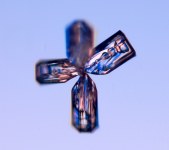 |
| July 23rd |
Some of the strangest clouds I've seen so far are the cirrus uncinus (above) during a beautiful late-afternoon canoe trip on Henderson Inlet and Woodard Bay. These are high, wispy ice clouds and, from what I could tell, were forming in the eastern sky in the direction of Mt. Rainier. I couldn't see the mountain from the bay, but I could detect a distant layer of clouds from whence these strange tufts seemed to generate. Clumps of them rose from the east and "flew" across the sky, gradually dissipating as their icy tails lengthened and evaporated.
 |
| July 29 |
Here is my bike, Cloud Chaser, (above) on board the ferry to Lummi Island. Thanks to the Whatcom County Transit System, we were able to take our bikes on the bus from downtown Bellingham to the ferry terminal at Pigeon Point ($7!). Our panniers and buckets held our clothes, birthday presents, a bottle of champagne, olives, cheese, and a baguette. Once off the ferry, we biked to the north end of the island to a yurt for the weekend.
Oh, but the clouds.The cumulus congestus rising over my handlebars, Bellingham, and the North Cascades remained low and distant. They did not do what they might have on the East Coast: continue their convective fury and turn into dark and stormy cumulonimbus.
At dinner one night, while we were grandly amusing our bouches, we had quite a spectacular show of altocumulus lenticularis, the lens-shaped clouds (below), over the Strait of Georgia.
The best show of all took place atop Mt. Rainier (below) where my father (visiting from the inferno of Washington, DC) and I planned to stroll amongst the alpine wildflowers and bask in the sun like marmots. Well, the trails at Paradise were still deep in snow and therefore closed to anyone without crampons and an ice axe. My dad and I wore sneakers just to make sure we didn't get corralled into some group summit climb.
 |
| August 2 |
Happily, we strolled around in the sunny parking lot and just stared up at the mountain, looking through binoculars at the blue-ice crevasses of the Nisqually Glacier (in lower right quadrant of photo above) and watching the peak. While we were there, a distinctive cloud started appearing--a cap cloud--one most often seen on high mountaintops, especially isolated peaks. The cloud appears to be stationary, stuck on the peak like a cap on a head, but that is an illusion. Up close, you can watch the cloud forming on the windward side and dissipating on the leeward side. As air moves up the mountain flank, it cools and condenses. As it descends, it warms and evaporates. The cloud was continually "appearing" on our left and "disappearing" to our right in equal measure.
 |
| August 4 |
Me? I like my clouds silent and tyrannical.









